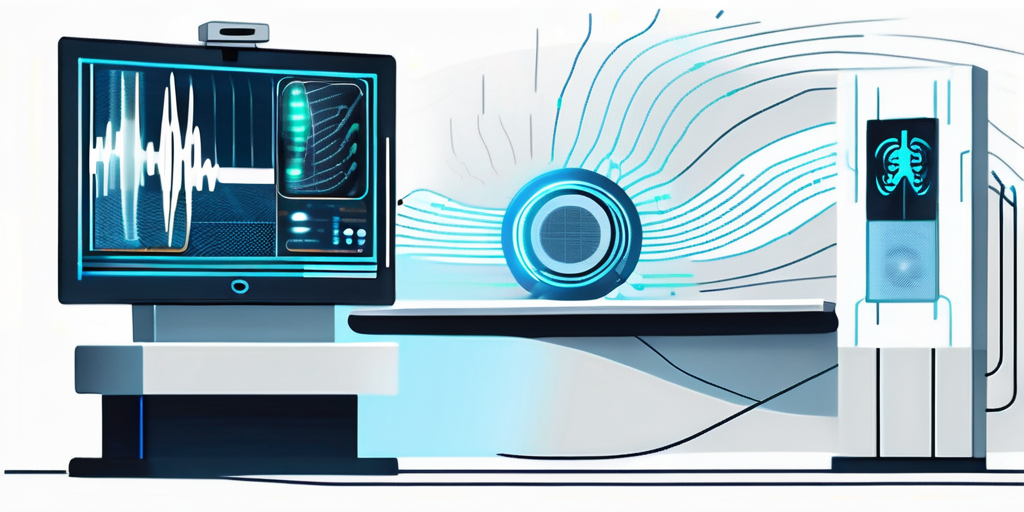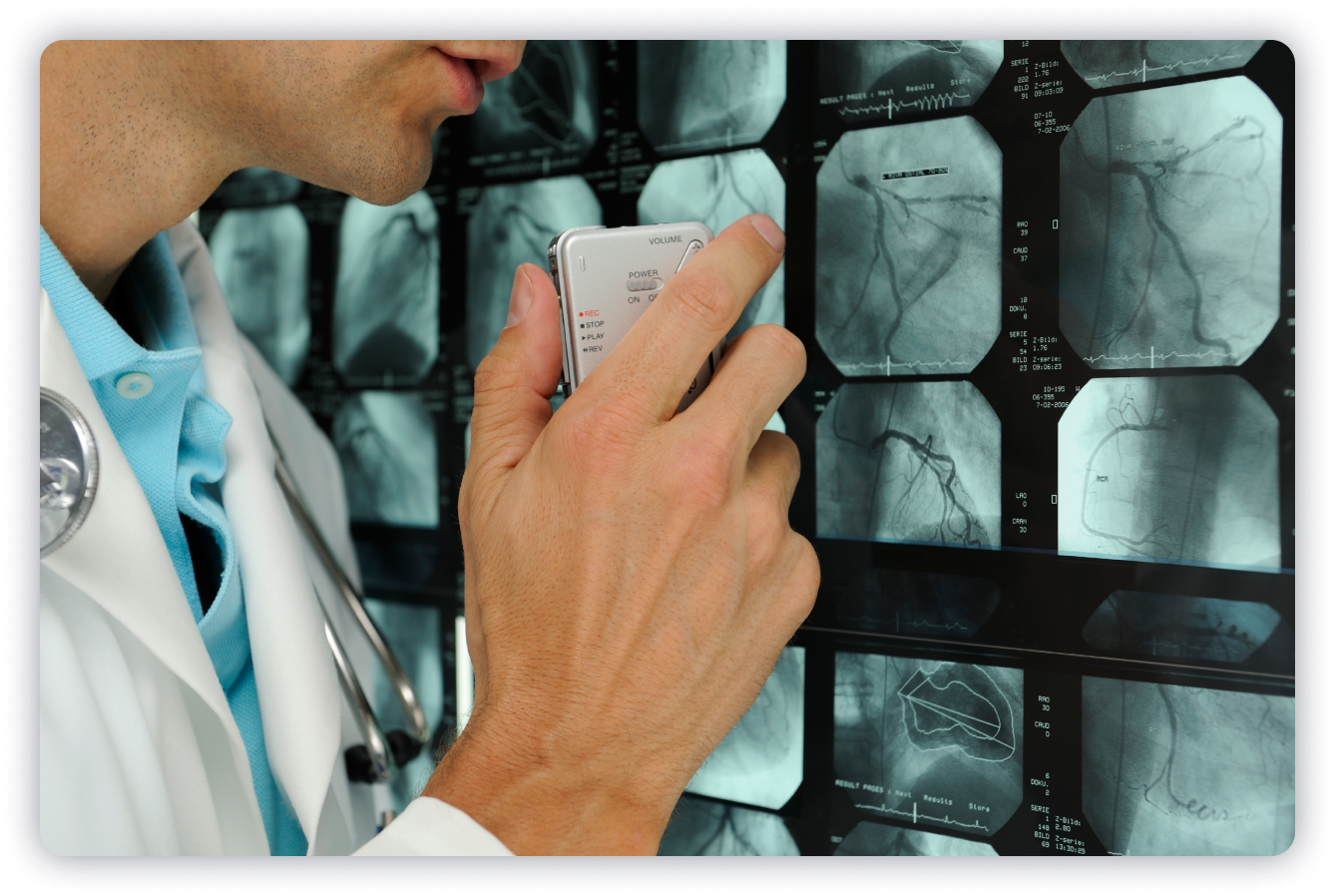In recent years, voice recognition technology has revolutionized the field of radiological diagnostics. As computers and software become more sophisticated, the use of voice recognition has become increasingly prevalent in the medical industry. This article delves into the various aspects of voice recognition technology in radiology, its role in diagnostics, the benefits it offers, the challenges involved, and the future possibilities it holds.
Understanding Voice Recognition Technology
Voice recognition technology is the ability of a computer system to interpret and understand human speech. This technology relies on complex algorithms and machine learning to convert spoken words into text. It has come a long way since its inception and has become remarkably accurate and reliable.

When it comes to voice recognition, there are several key components that work together to make it possible. One such component is the microphone, which captures the user's voice and converts it into an electrical signal. This signal is then processed by the system, where algorithms analyze the sound patterns and extract meaningful information.
But how does the system know what words or phrases to match the sounds to? This is where the database of known words or phrases comes into play. Voice recognition technology relies on a vast collection of linguistic data to accurately interpret and transcribe spoken words. This database is constantly updated and refined to improve the accuracy and reliability of the system.
The Basics of Voice Recognition
The process of voice recognition involves three main steps. Firstly, the system captures the user's voice through a microphone. Then, it converts the voice into digital data, using algorithms to analyze the sound patterns. Lastly, the system matches the sounds to a database of known words or phrases and generates the corresponding text.
One of the challenges in voice recognition technology is dealing with variations in speech patterns and accents. Different individuals may pronounce words differently or have unique speech patterns, which can make it difficult for the system to accurately transcribe the spoken words. To overcome this challenge, voice recognition systems employ sophisticated algorithms that can adapt and learn from different speech patterns, improving their accuracy over time.
Another important aspect of voice recognition technology is its ability to handle different languages. As the world becomes more interconnected, the demand for multilingual voice recognition systems has grown. These systems are designed to recognize and transcribe speech in multiple languages, opening up new possibilities for communication and accessibility.
The Evolution of Voice Recognition in Healthcare
Voice recognition technology in healthcare dates back to the 1980s. Initially, it was primarily used for transcription purposes, where medical professionals dictated their notes and reports. However, advancements in natural language processing and machine learning have enabled voice recognition technology to be integrated into various healthcare applications, including radiological diagnostics.
In the field of radiology, voice recognition technology has revolutionized the way radiologists interpret and report on medical images. Instead of manually typing out their findings, radiologists can now use voice commands to dictate their observations, which are then transcribed into text by the system. This not only saves time but also reduces the risk of errors that can occur during manual data entry.
Furthermore, voice recognition technology has the potential to improve patient care by enabling real-time documentation of medical encounters. Doctors can use voice commands to record their interactions with patients, capturing important details and observations without the need for manual note-taking. This allows for more accurate and comprehensive medical records, which can aid in diagnosis, treatment planning, and follow-up care.
As voice recognition technology continues to evolve, its applications in healthcare are expected to expand even further. From assisting in surgical procedures to enhancing telemedicine experiences, voice recognition has the potential to revolutionize the way healthcare professionals interact with technology and provide care to patients.
The Intersection of Voice Recognition and Radiology
As radiological diagnostics heavily rely on accurate and efficient documentation, the integration of voice recognition technology has been instrumental in improving the workflow and increasing productivity in this field.

The Role of Voice Recognition in Radiological Diagnostics
Voice recognition technology has played a significant role in transforming the diagnostic process for radiologists. Instead of manually typing reports and findings, radiologists can now dictate their observations directly into the system, allowing for real-time transcription and efficient documentation.
This technology utilizes advanced algorithms and machine learning to convert spoken words into written text. It recognizes the unique voice patterns and accents of individual radiologists, ensuring accurate transcription. The system also adapts to the radiologists' preferences and vocabulary, making the documentation process more personalized and efficient.
By eliminating the need for manual data entry, voice recognition technology saves valuable time for radiologists, enabling them to focus more on the interpretation of images and the formulation of accurate diagnoses. This not only improves efficiency but also enhances the quality of patient care.
Benefits of Integrating Voice Recognition in Radiology
The integration of voice recognition technology in radiology offers numerous benefits. Firstly, it improves the overall accuracy of the diagnostic reports. By capturing the radiologists' spoken words and translating them directly into text, the chances of transcription errors are minimized, ensuring the precision and integrity of the reports.
Moreover, voice recognition technology enhances the consistency of documentation across different radiologists. It standardizes the language used in reports, ensuring clarity and reducing ambiguity. This promotes better communication among healthcare professionals and facilitates more accurate treatment decisions.
Furthermore, voice recognition technology increases the efficiency and speed of report generation. Radiologists can dictate their findings in real-time, eliminating the need for manual typing or dictation. This streamlined process allows for faster turnaround times, enabling timely communication of results to physicians and ultimately benefiting patient care.
In addition, voice recognition technology can assist radiologists in managing their workload more effectively. It offers features like voice commands and shortcuts, allowing radiologists to navigate through the system and access relevant information quickly. This saves time and reduces the cognitive load on radiologists, enabling them to handle a higher volume of cases without compromising accuracy or quality.
Furthermore, the integration of voice recognition technology in radiology promotes a more ergonomic work environment. Radiologists can dictate their reports while sitting comfortably, reducing the risk of repetitive strain injuries associated with prolonged typing. This not only improves radiologists' well-being but also contributes to the overall sustainability of the healthcare system.
Overall, the intersection of voice recognition and radiology has revolutionized the diagnostic process. By harnessing the power of speech-to-text technology, radiologists can streamline their workflow, enhance accuracy, and improve patient care. As technology continues to advance, voice recognition is expected to play an even more significant role in the future of radiological diagnostics.
Challenges and Solutions in Implementing Voice Recognition
While voice recognition technology offers numerous advantages, its implementation in radiological diagnostics does come with certain challenges that need to be addressed.
Voice recognition technology has revolutionized various industries, including healthcare. In radiological diagnostics, it has the potential to streamline the reporting process, enhance productivity, and improve patient care. However, before fully embracing this technology, it is essential to understand and overcome the challenges that may arise.
Potential Obstacles in Voice Recognition Adoption
One of the primary challenges in adopting voice recognition technology is the initial training required for the system to accurately interpret and transcribe the radiologists' speech. The technology relies on machine learning algorithms that improve over time with user feedback. Therefore, during the initial stages, radiologists may experience some frustration as the system adjusts to their unique speech patterns and terminology.
Moreover, the accuracy of voice recognition systems can be affected by various factors, such as background noise, accents, and speech disorders. These challenges can hinder the seamless integration of voice recognition technology into radiological diagnostics.
Overcoming Challenges: Strategies and Solutions
To overcome the challenges associated with voice recognition adoption, proper training and education are crucial. Radiologists should receive comprehensive training on using the technology effectively and making the necessary adjustments to optimize voice recognition accuracy.
Furthermore, developing a standardized radiology vocabulary and terminology can significantly improve the accuracy of voice recognition systems. By creating a shared language, radiologists can ensure that the system understands and transcribes their speech accurately.
Additionally, collaborating closely with software developers and constantly providing feedback on system performance can help refine the algorithms and ultimately improve user experience. Radiologists' input is invaluable in enhancing the technology's ability to recognize and interpret medical terms and phrases accurately.
Moreover, integrating voice recognition technology with other existing systems, such as picture archiving and communication systems (PACS), can further optimize workflow efficiency. By seamlessly integrating voice recognition technology with PACS, radiologists can dictate reports directly into the system, eliminating the need for manual data entry and reducing the risk of errors.
It is also essential to consider the impact of voice recognition technology on radiologists' workflow and workload. While the technology aims to improve efficiency, it is crucial to ensure that radiologists do not experience an increased burden due to additional responsibilities associated with voice recognition implementation. Proper allocation of resources and workload management strategies should be considered to mitigate any potential negative effects.
In conclusion, while voice recognition technology brings numerous benefits to radiological diagnostics, its successful implementation requires addressing various challenges. Through proper training, education, collaboration with software developers, and integration with existing systems, these obstacles can be overcome. By embracing voice recognition technology, radiologists can enhance their productivity, improve accuracy, and ultimately provide better patient care.
The Future of Voice Recognition in Radiological Diagnostics
The future holds exciting possibilities for the further integration and advancement of voice recognition technology in radiological diagnostics.

Voice recognition technology has already made significant strides in the field of radiology, revolutionizing the way radiologists and healthcare professionals interact with diagnostic systems. However, the potential for further development and improvement is immense.
Predicted Developments in Voice Recognition Technology
Technological advancements, such as the use of artificial intelligence and deep learning algorithms, are expected to enhance the capabilities and accuracy of voice recognition systems. These developments will not only improve the transcription process but also enable the systems to understand complex medical jargon and context-specific speech.
Imagine a future where voice recognition technology can accurately decipher and interpret radiological reports, eliminating the need for manual data entry and reducing the chances of human error. With the integration of advanced algorithms, these systems will be able to analyze and interpret medical images more efficiently, providing radiologists with valuable insights and assisting in the diagnostic process.
Furthermore, voice recognition technology is likely to become more adaptable and customizable to individual radiologists' preferences. Radiologists will be able to train the system to recognize their unique speech patterns and medical terminology, further enhancing the accuracy and efficiency of the diagnostic process.
Implications for Radiologists and Healthcare Professionals
As voice recognition technology continues to evolve, radiologists and healthcare professionals can expect more efficient and intuitive systems. These advancements will streamline the diagnostic process further, paving the way for increased productivity, improved accuracy, and enhanced patient care.
With the integration of voice recognition technology, radiologists will be able to focus more on analyzing and interpreting medical images, rather than spending valuable time on administrative tasks. This shift in workflow will not only improve radiologists' job satisfaction but also allow them to dedicate more time to complex cases and provide better patient care.
Moreover, voice recognition technology has the potential to enhance collaboration and communication among healthcare professionals. Imagine a scenario where radiologists can dictate their findings directly into the system, and the information is instantly shared with other healthcare providers involved in the patient's care. This seamless integration will lead to faster and more effective decision-making, ultimately benefiting patient outcomes.
In conclusion, voice recognition technology is transforming the landscape of radiological diagnostics. Its integration in radiology has streamlined the diagnostic process, improved accuracy, and increased efficiency. While there are challenges in its implementation, proper training and collaboration can overcome these obstacles. The future holds promising developments that will further enhance voice recognition, benefiting radiologists, healthcare professionals, and ultimately, patient outcomes.

-1.png)







